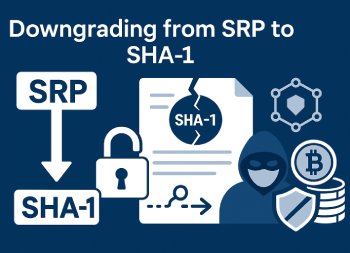Key Differences in Security Protocols

The Secure Remote Password protocol lets users prove who they are without actually sending their password online. It uses strong encryption along with something called zero-knowledge proofs, so your identity gets confirmed without exposing your password. On top of that, it’s made to prevent attackers from reusing old login data or snooping on your sign-in, which is why it’s trusted for things like crypto wallets.
SHA-1, by comparison, is a pretty old tool from the 1990s. It used to be standard for checking if data was intact and for hashing passwords, but over the years people found cracks in it. Hackers figured out how to make collisions happen — that’s when two different inputs produce the same hash. Because of that problem, SHA-1 can’t really be trusted anymore, especially against modern cyberattacks that are way more sophisticated.
The Risks of Downgrading from SRP to SHA-1

Swapping out SRP for SHA-1 or other outdated methods carries some pretty big risks. SHA-1 by itself isn’t enough for secure password checks because it’s only a hashing tool, not a full authentication system like SRP. When it’s not handled the right way, SHA-1 can leave passwords and other sensitive info exposed to a bunch of different attacks, like:
- Collision Attacks: Attackers can create different pieces of data that produce the same SHA-1 hash, which breaks trust in data integrity and authentication.
- Preimage Attacks: Since SHA-1’s hashing isn’t very strong, hackers with enough computing power can reverse or crack the hash to uncover the original passwords.
- Replay and Man-in-the-Middle Vulnerabilities: Without SRP’s secure handshake, attackers can intercept or replay login messages to get unauthorized access.
For anyone handling cryptocurrency, these weaknesses can cause real trouble—like losing money, having assets stolen, and facing ongoing privacy risks.
Why Younger and Less Experienced Users Are Particularly Vulnerable
A lot of younger crypto users, who often don’t have much experience with digital security, might not realize how crucial the protocols protecting their accounts actually are. They tend to focus more on easy interfaces and fast access, sometimes overlooking the risks. When platforms swap out solid protocols like SRP for weaker ones like SHA-1 without explaining it, users just don’t know what’s happening. That can cause a bunch of issues, such as:
- Users might not update their passwords or improve security settings, even when the risk goes up.
- They often don’t realize their accounts are more vulnerable, which makes it easier for hackers to target them.
- Phishing and social engineering attacks become more effective when the security protocols are weak.
This all adds up to less experienced users being way more exposed to hacks that stronger protocols could have blocked.
Strengthening Security with Proper Protocol Choices
To keep these risks in check, crypto platforms have to stick with strong, current security methods like SRP or other zero-knowledge proof techniques. These setups handle authentication securely from beginning to end, which helps prevent passwords from being exposed or grabbed by attackers.
But it’s not just about the tech. Getting users clued up on why secure authentication matters makes a big difference. When people know what’s at stake, they’re more likely to demand better safeguards and stay alert. Platforms also need to run regular checks and updates on their crypto standards to stay one step ahead of new threats.
Summary
Replacing strong authentication methods like SRP with weaker ones such as SHA-1 puts cryptocurrency users in a tough spot. Younger or less tech-savvy folks might not see the risks they’re facing. When security protocols are weak, accounts become easy targets for all kinds of cyberattacks, putting both digital assets and personal info at risk. Staying on top of security standards and helping users grasp why good security matters are crucial if the crypto community wants to stay safe.
Quick Links
Security Tip: Use a unique password for each of your accounts. Consider using a password manager to keep track of them all securely. #Password #Security #StaySafe pic.twitter.com/f7wUaj1vwd
— Birak IT Services Southampton (@BirakIT) June 27, 2025